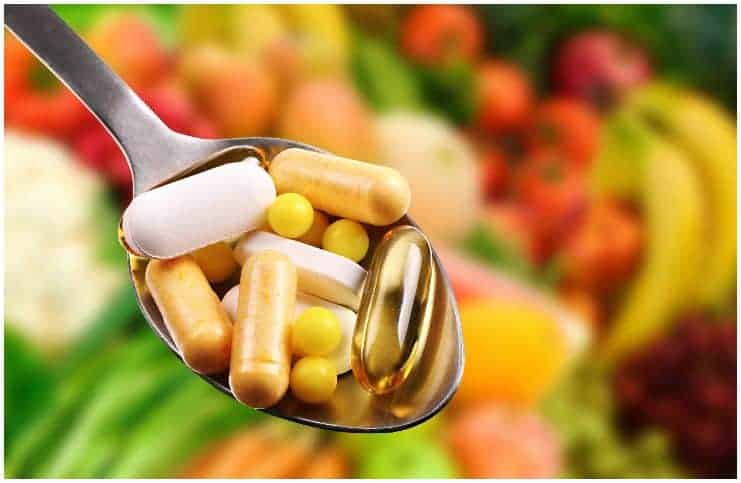Manganese (Mn)
It is an essential trace mineral required for a variety of vital functions, such as – production of digestive enzymes, nutrient absorption, immune-system defenses, and bone development.
The human body contains about 20 mg of Mn, and it is primarily concentrated in the pancreas, liver, bones, and kidneys.
Health Benefits
Antioxidant Properties
Due to the antioxidant properties of this trace mineral, the health benefits of Mn include a function of controlling the activity of free radicals in the body.
These free radicals are groups of atoms that contain an odd number of electrons.
Free radicals can be formed when some types of molecules interact with oxygen. Nevertheless, if antioxidants are not sufficiently available in the body, they become excessive and healthy cells suffer damage. Ultimately, this may cause DNA damage and impaired immunity.
Moreover, it is an essential component of many metalloenzymes, including – glutamine synthase and phosphoenol-pyruvate decarboxylase.
Osteoporosis
In the United States, about 50 million people are affected by osteoporosis. Worldwide, 1/10 of women over 60 years suffer from this bone condition.
This mineral, alongside vanadium and boron, are much-needed components of bone maintenance and building.
According to research, consuming foods rich in Mn is an effective and straightforward method to help increase spinal bone mineral density in postmenopausal women.
Also, Mn helps build strong bones, it is involved in the production of the thyroid hormone and helps the body metabolize protein and fat.
Diabetes
Type 2 diabetes mellitus is a metabolic disorder that affects the body’s use of sugar, the primary fuel of cells.
A few studies have concluded that Mn has a therapeutic action in the regulation of glucose levels by directly helping the enzyme responsible for sugar metabolism.
Deficiency
Although a deficiency in Mn is rare, specialists estimate that more than one-third of the people in the US do not get the recommended daily intake of this essential trace mineral from their nutrition.
Signs and symptoms of deficiency include – vision problems, bone malformation, high LDL and total cholesterol levels, hearing problems, infertility, hypertension, heart disorders, weakness, muscle contraction, memory loss, and seizures.
Food Sources
Healthy foods containing Mn include – pecans, hazelnuts, Macadamia nuts, walnuts, cashews, almonds, pumpkin seeds, pistachios, sesame seeds, chia seeds, sunflower seeds, flaxseeds, chickpeas, red kidney beans, white beans, adzuki beans, mung beans, black-eyed beans, amaranth leaves, spinach, Swiss chard, beet greens, and napa cabbage.
Side Effects
Large doses of supplements containing Mn can cause neurological adverse effects, that commonly resemble the signs and symptoms of Parkinson’s disease.
Also, individuals living close to a steel factory (which has Mn emissions) are at higher risk of developing this neurodegenerative condition.
Side effects have also been seen in people who received high amounts of intravenous nutrition (containing Mn) over long periods of time.
Magnesium (Mg)
It is an essential mineral required for the function of more than 300 enzymes. It is thought to be the most important trace element in human health.
About 40% of the Mg resides in soft tissue cells and muscle while approximately 60% resides in the bones.
Health Benefits
Cardiovascular Health
A stroke happens when the blood supply to the brain is interrupted. It is the 5th leading cause of death for people in the US, with one American having a stroke every 40 seconds.
Regularly consuming foods rich in Mg can considerably reduce the risk of a stroke by 8%, according to a study issued in the American Journal of Clinical Nutrition.
Natural Remedy For Migraine Headaches
Migraine headaches can last even for a few days and commonly occur three times a month. Recent research has concluded that an intake of around 450 milligrams of Mg per day (from diet) reduced the frequency of migraine headaches by 40%.
Attention Deficit Hyperactivity Disorder
ADHD is a mental health disorder that can affect child relationships as well as his success at school. Research has established that children who intake 200 milligrams of Mg a day for more than 200 days had a considerable decrease of hyperactivity compared to their symptoms before taking these supplements.
Deficiency
Around fifty percent of all the people in the United States is taking in less Mg than they should, according to the U.S. Department of Agriculture.
Other statistics show that only 25% of Americans are getting the recommended daily amount, which is about 410 mg for adult men and 315 mg for women.
If you are having a deficiency in Mg, you may experience the following symptoms – weakness, sleepiness, abnormal rhythms of the heart, nausea, poor appetite, seizures, muscle cramps, and numbness.
Food Sources
Foods rich in this essential mineral include – sesame seeds, chickpeas, pine nuts, pumpkin seeds, Brazil nuts, walnuts, figs, oat bran, almonds, flaxseeds, cashews, peanuts, turnip greens, broccoli, dates, pecans, pistachios, avocados, spinach, Swiss chard, black beans, prunes, bananas, quinoa, apricots, wild rice, red kidney beans, millet, lentils, kale, zucchini, and raisins.
Side Effects
The side effects of taking supplements with this mineral are very common. Signs and symptoms include – increased urination, slow heartbeat, dizziness, drowsiness, muscle paralysis, blurred vision, and flushing.
For patients with impaired kidney function, the risks of taking these supplements are increased, hence, it is recommended to talk with your healthcare specialist prior to use. Individuals who have heart blocks, a medical condition where the heart beats too slowly, need to take additional precautions.
Bottom Line – Manganese vs Magnesium
Both minerals are vital nutrients but serve different functions, with Mg thought to be more important to human health.
Images credit – Shutterstock
READ THIS NEXT: Molybdenum – Side Effects
References https://www.sciencedaily.com/releases/2017/09/170921090251.htm https://www.sciencedirect.com/science/article/pii/0021968166900944 http://www.health.state.mn.us/divs/eh/risk/guidance/gw/mninfosheet.pdf

How much greens do we need to eat to have enough magnesium? I suffer from fibromyalgia, headache last, neck pain, Epstein Barr, Gerd
I juice with kale, spinach, blueberries, yogurt and raw honey in the morning. I take a good multi vitamin for stress and weight support, along with vitamin d3 and a good fish oil and w10. I’m 64, suffering from early 40’s